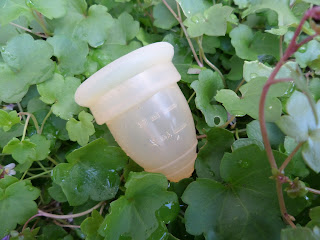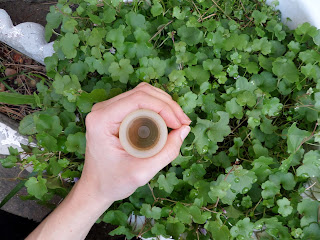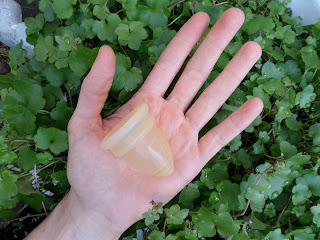The Mooncup was my first foray into eco-friendly menstruation; and back then (I’m talking circa 2007), the idea of bleeding into the same cup for years was pretty radical. And, if I’m honest, marginally unpleasant. I liked the earth-friendly aspect, but the size comparison between the Mooncup and the various feminine hands gracing the product photography was a bit daunting. Tampons are roughly the same diameter as a finger, and this thing was like the hollow created by a loosely-held fist. Seventeen-year-old me had been brainwashed by the misinformation that smaller and tighter vaginas are better, and that you can irreparably stretch your vagina through penetrative activity of any kind. I was very dubious about inserting something so large. The environment would have to wait.
A couple of years later I was at university, and on a strict budget. Tampons were almost R50 for a box that wouldn’t even last a full two cycles (ah, those were the good days – now it’s even more expensive to have the privilege of not leaving a trail of carnage everywhere you go), and I started reconsidering menstrual cups. It was still a big investment to make, yet at that point I was fairly invested in the imported UK-branded Mooncup as opposed to the cheaper South African alternatives that had recently emerged onto the market. The Mooncup was the one that I had researched and considered, and it was the brand with which I had built an imaginary relationship. So it was the investment I made, and at that point it was a sickening amount of money. That was in 2009, and had I known that I would still be using my Mooncup to this day, I would have laid my cash down sooner and more gladly.
The Mooncup is a little silicone blood-goblet that comes in two sizes: A for After Childbirth, and B for Before Childbirth. Size B is of a slightly smaller diameter, although the size difference is only a few millimetres. Each cup has with convenient measurement guidelines and is perforated by four tiny holes that help facilitate a seal that prevents leakage. The silicone is flexible enough to be folded lengthways and inserted, yet also maintains enough structural integrity to hold its shape. Because it is made from a non-absorbent, body-safe material, the risk of developing Toxic Shock Syndrome is lower than with tampons. Also, there’s no chance of drying out your delicate vaginal tissues or leaving traces of bleached fibres behind.
In fact, this was my dominant first impression of the Mooncup. After the initial adjustment period (what feels comfortable? How does one insert it without it popping open unexpectedly and causing me a surprising bolt of pain?), I found it fascinating to be able to see the separation between blood and other vaginal fluid within the little cup. All of that gets absorbed during tampon use, leaving the vaginal canal dry. Not exactly ideal. If you’re not squeamish, it’s definitely a way to better understand your body. You start to learn that it’s easier to insert the cup while standing, but remove it in a squat. You figure out that it’s better to dump blood as far back into the toilet bowl as possible, because its viscosity will take a few flushes to properly dissipate and that’s just not ideal in a public restroom. Eventually, you might even get brave enough to trim the annoying 'removal stem' off entirely, because you don’t use it anyway. You sail past the sanitary aisle in supermarkets, gleefully congratulating yourself on your investment. Menstrual cups are the best.
Except when you spill. If you don’t empty the cup timeously, the resulting overflow can compromise the seal and create a rather grisly accident. To be honest, sometimes I don’t even know why the seal breaks – it can happen seemingly at a whim, even when the cup is almost empty. It’s a bit frustrating at times. Also, the four holes which create the seal are prone to clogging with uterus detritus. Ditto measurement levels and the apparently superfluous branding on the inside of the cup. It just means you need to spend a bit more time making sure everything is clean. At least the holes are easy to get to – filling the cup with water, covering the top with your palm and then squeezing creates a pressurised stream that forces any detritus out. In recent iterations of the Mooncup, the holes have been made vertically rather than in mine, where they are horizontal and prone to collecting gunk. I only discovered this upon buying one for a friend, who was initially sceptical but became a menstrual cup convert and ended up telling her friends to invest as well. Her cup seemed to be made from a clearer, paler silicone, but other than the holes the design seems mostly unchanged.
On the subject of the colouration, I much prefer the paler tones of the more recent cup. The Mooncup website claims that tonal variation of the silicone will occur, but even when I got mine it was a dull yellowish colour that is a bit unappealing. Eight years later and it was, understandably, a bit stained. But don't be alarmed! You can help refresh your cup with a hydrogen peroxide soak -- it's quite safe, just make sure you rinse and dry the cup thoroughly afterwards.
Overall, I think menstrual cups should be used by anyone with a period -- it's good for the environment, and is an investment that will save you money for years. My cup paid for itself in just over a year; and that was when a pack of 40 tampons was R45. I've saved so much money not buying disposable tampons or pads, and my Mooncup is still going strong.
However, I realise that it's not for everybody. If you are squeamish, this is probably not for you. If you only ever use tampons with an applicator, this is definitely not for you. For some people, having the lining of their organs leave their body in a spectacularly messy and painful display is an ugly experience that borders on traumatic, and I completely understand the need to distance oneself from the grisly nature of it all.
However, if you can handle it and want to try a sustainable and cost-effective way of managing your period, I strongly suggest switching to a menstrual cup. I can vouch for the Mooncup, but there are even cheaper alternatives out there. Go forth and have your periods sustainably!










No comments:
Post a Comment